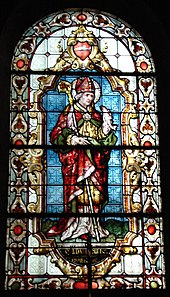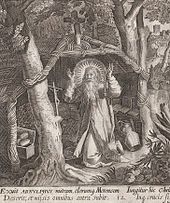Arnulf of Metz


Arnulf von Metz , French Arnoul de Metz , also Saint Arnould , Arnoulf (born August 13, 582 ? In Lay-Saint-Christophe near Nancy ; † July 18, probably 640 near Remiremont ) was the progenitor and saint of the Carolingians . From 614 to 629 he was Bishop of Metz .
Life
Nothing is known about Arnulf's ancestors including his parents (see also: False Merovingians ). He reached a high position with Theudebert II of Austrasia . In 612 Arnulf von Metz was ordained a priest after his wife Doda had entered a monastery . In 614 he was made bishop of Metz, but retained his political offices.
Together with Pippin d. Ä. In 613 he laid the foundation for the rise of the later Carolingians by calling on the help of the Neustrian King Chlothar II against the widow of King Sigibert I , Brunichild , who ruled in Austrasia and Burgundy . After their overthrow, Chlothar ruled the entire Franconian Empire , but had to recognize the positions of power of the Austrasian nobility in the Edictum Chlotharii .
From then on, Arnulf made himself indispensable as an advisor at the court of Chlothar. When in 623 Chlothar's fifteen-year-old son Dagobert I was appointed sub-king in Austrasia, Arnulf assumed the influential position of his tutor. However, after he and Pippin largely lost their influence when Dagobert moved to Neustria in 629 to take control of the entire Franconian Empire , he resigned his episcopate and retired to Remiremont Abbey in the Vosges, where he cared for lepers and probably 640 too has died. He was first buried in the place where he died, but later reburied in the Abbey of St. Arnulf Church in Metz .
progeny
Arnulf von Metz had two sons from his marriage:
- Chlodulf , who also became Bishop of Metz around 660
- Ansegisel , recorded in 662, was slain before 679. He married Begga , Pippin's daughter, and with this marriage laid the foundation for the rise of the Carolingians.
Legends
Arnulf von Metz is venerated as a saint in the Catholic Church . He is the patron saint of beer brewers and millers , around whom many legends have grown up. You turn to him when you've lost something. His feast day is July 18th.
His election as bishop
After his wife Doda entered the monastery, as well as during his own ordination as a priest, Arnulf felt by no means worthy to accept the office of bishop in Metz after he had been elected. He would have preferred a simple life as a monk , reports the biography. To be sure that it was God who had called him to this office, he threw his bishop's ring into the Moselle and prayed that God would give him the ring again when Arnulf had been granted the grace of God again.
A few years later, when Arnulf was already a bishop, a fisherman brought a fish to the cook of the Metz bishop. When the cook cut up the fish for preparation, the bishop's ring reappeared, which Arnulf had previously thrown into the Moselle. After the cook had given the bishop his ring, Arnulf interpreted this as a sign from God that his sins were forgiven and continued the bishopric in Metz. The background to the bishop's fear was that during his time as a politician, when he was not yet Bishop of Metz, he had committed numerous violations of Christian ethics. He is attributed complicity in the cruel end of the Austrasian Queen Brunichild . The golden Arnulfsring is currently on display in the Metz Cathedral Treasury. The ring made of heavy gold probably dates from the seventh century, the stone is likely to have been cut in the fifth century.
The beer miracle during its lifetime
According to tradition, during Arnulf's time as bishop, the Metz region suffered from the effects of polluted water. Arnulf realized that boiled water, such as that used in the brewing process, reduced this risk. Legend has it that he threw a crucifix into a beer kettle and blessed it. People only drank beer from this blessed kettle and the wave of disease receded. The saying when distributing the so blessed beer is said to have been: "Through man's work and the love of God, beer sees the face of the world."
Saint Arnulf in St. Arnual
According to a legend, Arnulf resigned his bishopric in 629 and retired to the Heidenkapelle (former Mithraeum ) on Halberg , where his alleged father, Saint Arnual , had already lived as a hermit. From there he initiated the construction of the chapel dedicated to John the Baptist (location of the St. Johann basilica ) in the fishing village of St. Johann. The fishing village then adopted the place name St. Johann from the title saint of this chapel.
The beer miracle in the transfer of his bones
After his death, his successor in the episcopate Goericus wanted to bring the remains from the Remiremont monastery back to Metz . The description of the saints tells that a great miracle happened. When the solemn procession marched through the streets in the summer heat on July 18th, the procession had to stop in the village of Champignuelles because the heat and the weight of the bones were no longer bearable. When people came to the only inn, there was only one tankard of beer for everyone, not counting 5000 men, women and children. So everyone shared this tankard, everyone drank and hoped for the intercession of Bishop Arnulf, who was already venerated as a saint. The miracle happened: everyone drank and this tankard of beer never got dry.
literature
- Friedrich Wilhelm Bautz : Arnulf, Bishop of Metz, saint. In: Biographisch-Bibliographisches Kirchenlexikon (BBKL). Volume 1, Bautz, Hamm 1975. 2nd, unchanged edition Hamm 1990, ISBN 3-88309-013-1 , Sp. 246-247.
- Ludwig Oelsner: Arnulf, Bishop of Metz . In: Allgemeine Deutsche Biographie (ADB). Volume 1, Duncker & Humblot, Leipzig 1875, p. 607 f.
- Eugen Ewig: Arnulf. In: New German Biography (NDB). Volume 1, Duncker & Humblot, Berlin 1953, ISBN 3-428-00182-6 , p. 397 ( digitized version ).
- Francis Schaefer: St. Arnulf of Metz . In: The Catholic Encyclopedia. Vol. 1. New York 1907.
Web links
- Arnulf von Metz in the Saarland biographies
- Arnulf
- Arnulf of Metz
- The biography (vita Arnulphi) in English translation
Individual evidence
- ^ Pierre-Édouard Wagner: La cathédrale Saint-Étienne de Metz des origines à nos jours, Ars-sur-Moselle / Vaux (Moselle) 2015, pp. 54-55.
- ^ Johann Peter Muth: Parish historical pictures of the Catholic parishes of St. Johann and Saarbrücken for the 150th anniversary of the consecration of the current parish church of St. Johann , St. Johann an der Saar 1908, p. 12.
- ^ Karl Lohmeyer : The sagas of the Saar from the source to the mouth. Saarbrücken 1951, p. 78.
- ^ Karl August Schleiden : Illustrated History of the City of Saarbrücken , Dillingen / Saar 2009, pp. 25-26.
| predecessor | Office | successor |
|---|---|---|
| Pappolus |
Bishop of Metz 614–629 |
Goericus |
| personal data | |
|---|---|
| SURNAME | Arnulf of Metz |
| ALTERNATIVE NAMES | St. Arnulf of Metz |
| BRIEF DESCRIPTION | Ancestor and house saint of the Carolingians |
| DATE OF BIRTH | August 13 at 582 |
| PLACE OF BIRTH | Lay-Saint-Christophe near Nancy |
| DATE OF DEATH | at July 18, 640 |
| Place of death | Remiremont |



